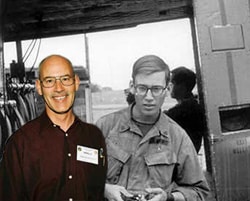From the Army Times
CO Gives Up His ‘Ship’
FSB 4-11, Vietnam With a gunship down and enemy nearby, an Americal Div battalion commander, Lt. Col. Roger A. Culbertson of Longview, Wash., of the 3d Bn, 1 st Inf made the crucial decision to attempt a rescue with his command and control helicopter. The rescue was successful, but to make room on the C&C ship, Culbertson and his operations officer, Capt. Robert Graham of Patchogue, N.Y., had to remain with the downed gunship.
Earlier, two “Shark” gunships from the 174 th Avn Co (Assault Helicopter), flying in support of the 11 th Inf Bde, returned the fire on five enemy personnel they had detected while on routine patrol 15 miles northwest of Duc Pho. On a resupply mission at the time, Culbertson used his C&C ship to airlift a nearby element of Co. C closer to the initial area of contact. The enemy’s automatic weapons fire continued to be directed at the two “Sharks,” however, and it was while making a low pass over the target area that one of the gunships burst into flames.
Within minutes, Culbertson’s helicopter was on the scene and soon afterward, Capt. Graham, along with 1 st Lt. Bill Brumley of Dallas, Sp4 Leroy Wilson of Lottsburg, Va., and the ship’s two door gunners, PFCs Abbey and Woodard were placing the casualties on board. All around them rounds were exploding as the munitions aboard the burning gunship were ignited.
With the nearest friendly element more than 800 meters away, Culbertson and Graham elected to remain on the ground so that the entire crew might be evacuated. Armed only with their pistols and a radio, the two officers waited nearly 20 minutes before Sgt. Stephen Ridnour of Linwood, Wash., and members of the 4 th Pltn reached their location.
LOH Crew Rescued
Arnold Dietrich in 2004 and 1970
CHU LAI, Vietnam — Three occupants of a helicopter that crashed near Hiep Duc recently were rescued minutes after impact by a crew chief who leaped weaponless into a ring of fire from his aircraft as it hovered 15 feet above the crash scene.
Sp5 Arnold C. Dietrich of Nortonville, Kan., crew chief on a “Rattler” UH-1H of the 71 st Avn Co. leaped from his seat to where the burning LOH of the Americal Div. artillery aviation section lay on a steeply-sloping hillside near LZ West.
The unarmed LOH had been attempting to extract wounded infantrymen from an LZ too small for a normal MEDEVAC helicopter. Heavy small arms fire tore into the ship as its pilot tried to gain altitude. Fuel spilling from its ruptured cells ignited, turning the aircraft into a ball of flame. Dietrich was the first to spot the pilot and artillery observer waving from the ground.
“We saw the fire, and right in the center I saw two people standing there waving. We couldn’t set down — there were too many rocks and trees,” said Dietrich.
The Rattler aircraft commander, Lt. Thomas V. Pratt of Ontario, Calif., acknowledged over the intercom what each man on board knew: “We’ve got to get in there and help them.”
Over the intercom, somebody said, “I’ll go.”
“Without hesitating, ‘D’ (Dietrich) grabbed a hand radio and jumped out of the aircraft,” said Capt. R. J. Sienkiewicz of Gilbertsville, N.Y., the pilot.
The door gunner, Sp4 Harold E. Justice of Sylva, N.C., readied a McGuire rig.
On the ground, Dietrich had already made contact with the pilot and helped him into the McGuire rig’s leg and torso loops.
Once the first man was in the rig, Pratt ascended vertically, and when the dangling man cleared all surrounding obstacle, made his first run toward nearby LZ West.
As the helicopter disappeared over the trees, the artillery observer showed Dietrich where a third man lay injured a short distance from the LOH wreckage..
Within minutes the helicopter returned and the second pilot was extracted. Again the chopper left, and Dietrich began to assess the third man’s injuries. The other two had sustained minor injuries, but were able to move without help.
Determining that he couldn’t be slung as the others had been, Dietrich decided to extract the third man using only the torso strap.
“I told him it would be uncomfortable, but it was the only way we could get him out.” Dietrich said.
He had reported the extent of the man’s injuries to the aircraft commander, who relayed to medical personnel on West. They warned that the man should not be moved. A ground rescue party was sent to the crash site but ran into heavy small arms fire from enemy positions between them and Dietrich.
Again the chopper returned, and by now the fiercely burning grass had almost engulfed the two men. As the third man was readied for extraction, the rotor wash from the hovering ship was the only thing saving the two men from the flames.
“Lieutenant Pratt did a fantastic job, keeping the aircraft aloft in all the turbulence from the fire. We had numerous blade strikes, but he kept his cool and stayed with it,” Sienkiewicz said.
When the ship left for the third time, Dietrich was alone: Again, the gunships had stayed with the helicopter, leaving him without air support. Uphill from the crash, the rescue group from West was still in enemy contact, and to the downhill side were the enemy gunners who shot down the LOH.
Weaponless, Dietrich hid between the rocks until he could hear the ship approaching, then he ran into the open and stepped into the dangling loops.
“All that was left of the LOH by this time was ashes and a four-foot section of the tail,” Dietrich said.
